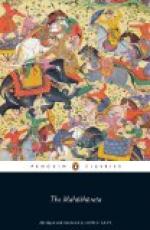|
This section contains 1,097 words (approx. 3 pages at 400 words per page) |

|
Indus Valley Civilization
Archealogical evidence has uncovered a somewhat mysterious Bronze Age culture that existed along the Indus river in what is today Pakistan, a nation situated to the immediate west of modern India. Contemporary with the ancient Mesopotamian and Egyptian civilizations, the Indus Valley culture thrived between about 2500 and 1500 BC. Largely agricultural, the Indus peoples seem to have had a relatively complex society and advanced material culture. They lived in mud-brick dwellings, produced art and pottery, lived under a loosely democratic form of government, and offered women a equitable status in relation to that of men. Other aspects of their social organization remain a mystery to archaeologists, though they worshipped and sacrificed to many gods, including Indra and Agni, both of whom appear in the Mahabharata. Their belief system also seems to have been an early form of the Vedic religion. Its precepts were later organized and...
|
This section contains 1,097 words (approx. 3 pages at 400 words per page) |

|




